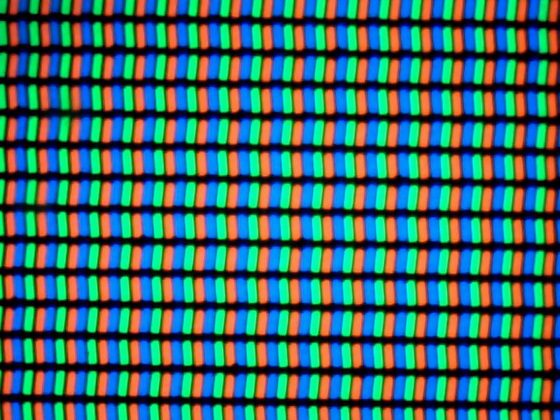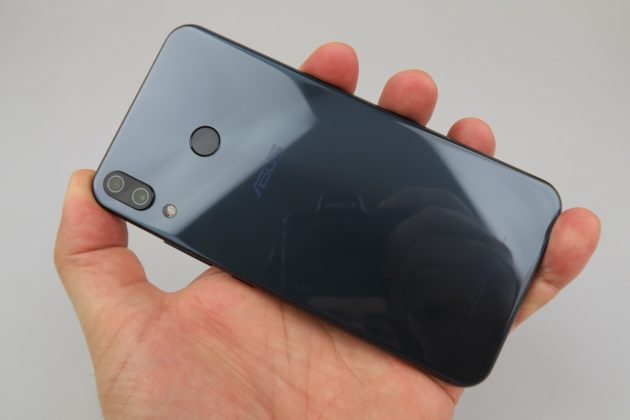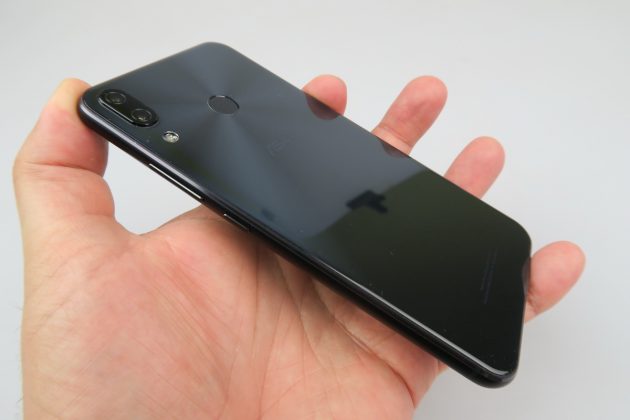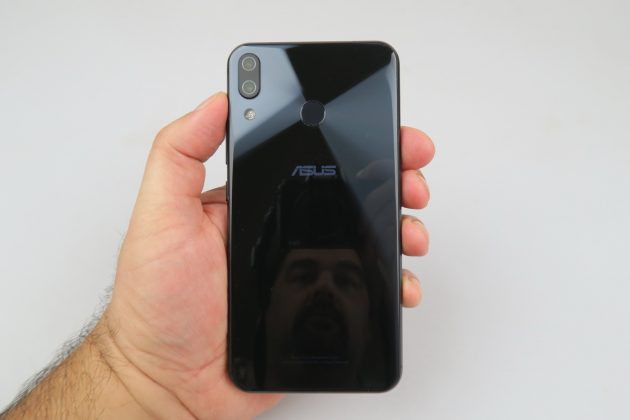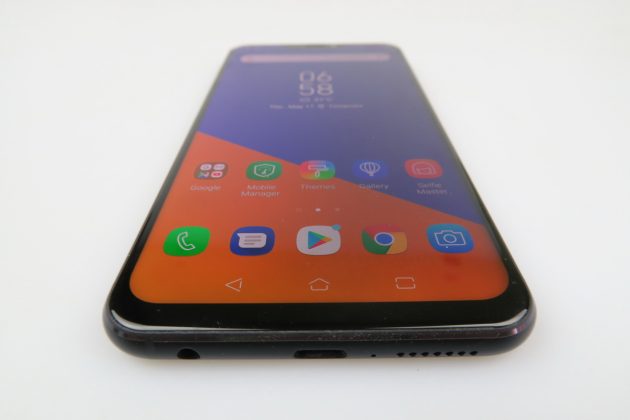ASUS ZenFone 5 ZE620KL is one of the first major Android devices with a notch unveiled earlier this year at MWC 2018. It follows the ZenFone 4 from September last year and it’s part of a trio that includes the ZenFone 5 Lite, ZenFone 5 and ZenFone 5z. They bet big on AI, affordable prices and the latest CPUs available. Pried at around $400, the device gets fully checked out below.
Design
At first sight, not much has changed from the predecessor, if you look at the back. Yes, the diagonal is bigger and yes there’s a notch upfront, those are the real changes. Available in Midnight Blue or Meteor Silver, the handset is pretty compact for a 6.2 inch machine and it kind of looks and feels like the iPhone X or the Huawei P20 Lite.

It’s got a glass back with a circular pattern that’s typical to the Zen products. There’s also a metal frame in the mix and the waistline is 7.7 mm, while the weight sits at 165 grams. Meanwhile the iPhone X is 7.7 mm thick and weighs 174 grams. Huawei P20 Pro is 7.7 mm thick and weighs 165 grams, so those are pretty much lined up for the same format.
ASUS ZenFone 5 has a comfy body and solid build, plus comfy buttons. One hand use is out of this world, for such a large diagonal and I was actually amazed by it. The back side kind of gets smudged after long usage (and a trip to KFC). Nice grip, premium materials and definitely some class.

Display
We are promised on paper a screen to body ratio of 90%, never heard before (when the device came out). It’s more like 83% in real life to be honest. The panel is a Super IPS+ with a 2246 x 1080 pixel resolution and 550 nits of brightness promised on paper. There’s also the 96% NTSC color gamut, DCI-P3 support and Gorilla Glass protection, as well as a Blue light filter and support for input even with gloves on.
This is quite the jump from the 5.5 inch Full HD screen of the ZenFone 4. The viewing experience was fine, with solid brightness and an OK contrast, plus vivid colors. It’s a bit below the OLEDs though, but it does provide wide view angles. Immersivity was so-so, on account of having the right side of the screen with curved corners in landscape mode and the left side a straight line.

Pixels have an RGB Stripe arrangement and the luxmeter test showed us a value of 491 LUX units, which is solid. It beats HTC U11, iPhone 7 Plus and ASUS ZenFone 4 (485 LUX), but scores below the Huawei P20 Pro and Galaxy S8, as well as the iPhone X. Settings are generous, as usual for an ASUS: brightness, auto brightness, smart screen on, nav bar options, display size and font size. But it doesn’t end here.
There’s still the ASUS Splendid section, with the option to get rid of the blue light (with a filter), a color temperature slider and a Color Mode (Wide Color, Standard or Custom). The latter includes a hue and saturation slider of course. It’s a pretty good screen overall, but the fact we didn’t have an option to hide the notch initially was a bit of a bummer.

Hardware
ASUS ZenFone 5 packs a Qualcomm Snapdragon 636 processor, a small jump from the Snapdragon 630 on the ZenFone 4. It also has the Adreno 509 GPU and 4 or 6 GB of RAM, as well as 64 GB of storage, of which 52 GB are available for the user. We have the 4 GB RAM version by the way. There’s also a microSD card slot here and I found the performance to be great.
Animations are uber fast and no matter what we threw at the phone, it didn’t stutter. We also played Riptide GP Renegade and had zero problems with it, with some pretty nifty textures and frame rate. We also player Dungeon Hunter Champions and it registered well with us, running perfectly. Of course, some people prefer benchmarks for a proper evaluation and we also have those.

In AnTuTu 6 for example we scored above the Huawei Mate 8 and Samsung Galaxy A8 (2018), but also below the Nokia 7 Plus and iPhone SE. In AnTuTu 7 we took it to above Xperia XA2 and Moto X4 but below the Nokia 7 Plus. GeekBench 4 Multi Core took us above the Moto Z2 Play and Galaxy A8 (2018), but also lower than the iPhone 7 and Nokia 7 Plus.
Finally the Slingshot 3.0 test placed us above the Moto X4 and Xperia XA2, but also below the Nokia 7 Plus and OnePlus 2. The GPU really doesn’t feel like much of an upgrade from what we got with the Snapdragon 630 and it gets beaten by the Snapdragon 660 I’d say. We also did a temperature test or two and achieved 32.1 degrees Celsius in GFXBench and 38.8 degrees in Riptide GP Renegade, so there’s no overheating.

Battery
This smartphone relies on a 3300 mAh battery, with fast charge and AI features. On paper a 5 minute charge means 2 hours of talk time and also on paper we are promised up to 22 days of 4G standby and up to 25 hours of 3G talk time. The bundled charger is a 5V/2A unit also at 10W. Leaving that aside, we got up to 9 hours and 55 minutes of HD video playback, which is just OK, no record here.
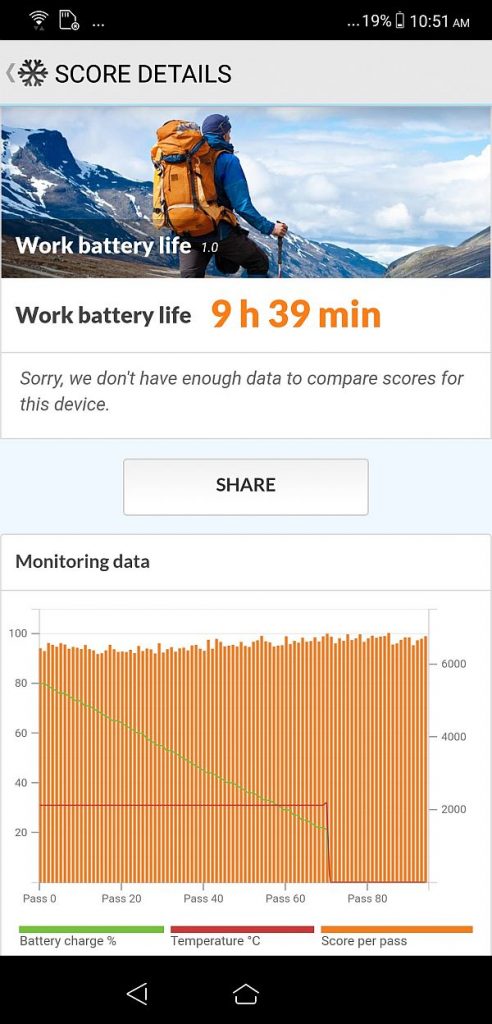
It’s better than the Xiaomi Mi A1, HTC 10 and HTC U Ultra, but that’s kind of it. Even the ZenFone 4 beats that value and the Huawei P10 Lite. In PCMark we reached a pretty great 9 hours and 39 minutes, which surpasses the Galaxy S7 Edge and Galaxy Note 8 even. Still, the Nokia 7 Plus and Xperia XA2 are clearly better, plus the Xperia XZ1 Compact.

Charging requires 2 hours and 5 minutes and I expected better here. It’s better than the Huawei P9 Lite, but that’s kind of it. Also the Pixel 2 XL… After 30 minutes of charging you get to 35% battery and after one hour you get to 69%, which is not that bad. Settings are once again generous, with modes like Performance, Normal, Power Saving and Super Saving. They also have custom tweaks for brightness, network and more.
Battery optimization is here as well and while the continuous usage was fine, the fact that ZenFone 4 beats us in a segment is not flattering for sure.

Audio
ASUS ZenFone 5 packs dual speakers, with dual amplifiers and the promise of Hi Res sound. There’s also DTS Headphone X tech here and the famous Audio Wizard is still available, with its tweaks. We’ve got a 5 magnet speaker here, according to ASUS and 24 bit acoustics. Our unit didn’t have bundled headphones, but it’s a test unit, so the final one may have them.
We used Google Play Music to play tunes and Audio Wizard is integrated within it. It has Quick Settings and modes like Stereo, Mono and Outdoor. With headphones attached you can activate modes like Normal, Vocal, Rock or Pop, but there’s also a Custom mode, with 6 channels. You can also mess around with bass and treble knobs. We’ve got DTS here, with options like Traditional, In Front and Wide. Leaving aside all of these options we go to our own ears and their own interpretation of the sound.

ZenFone 5 puts out a very loud sound, solid bass and the speakers can’t be covered in landscape luckily. There’s lots of vibration and the volume is so high, that it can cover a conversation in a small room. The outdoor mode makes the sound a bit strident and distorted though…
The headphones have great surround, at least those we played with, non official ones. FM radio is also in the mix. We did a decibel test and achieved 87.9 dBA at the front and back of the phone with our typical test audio sample, with no extra Boost.

With a boost we achieved 90.5 dBA, which beats the Galaxy Note 8 and ASUS ZenFone 3, plus the Galaxy S8 and Huawei P20 Pro. We scored below the Nokia 5 and Xperia L1, though… We also played Riptide GP Renegade and reached 99 dBA with no Boost and 102.6 dBA with boost. It’s the fifth placed phone all time, beating the likes of Nokia 7 Plus and Samsung Galaxy A8 (2018), but scoring below the Nokia 8.
Overall a pretty satisfying experience.

Camera
ASUS ZenFone 4 had an OK camera, but just OK, gravitating around the level of the LG G6, but not more. Let’s see if the ZenFone 5 is any better, particularly since on paper the camera setup sounds similar. There’s a dual 12 MP + 8 MP setup at the back, with the 12 MP shooter being a Sony IMX363 unit, with F/1.8 aperture and 4 axis stabilization. There’s also an LED flash here, OIS and EIS and the secondary back camera is an 8 MP wide angle unit with 120 degrees fo image to capture.
RAW capture is on the table and the selfie camera offers an 8 megapixel res, plus F/2.0 aperture and AI Beauty features. Zenimoji is in the mix too, applying AR masks to your face, even in real time when doing live Facebook video streaming for example. One thing I noticed is that the device offers 4X zoom only, has no optical zoom and lacks the 8X zoom we’ve gotten accustomed to on some many devices.

The camera UI has become simple compared to the ZenFone 3 for example. It’s got HDR, Depth/Portrait and offers modes like Beauty, Super Resolution, Panorama, Time Lapse, Auto, Pro, GIF, Slow Motion and filters.
The Pro mode lets you to tweaks for the white balance, exposure, ISO, shutter and focus. Selfies have 5 beauty options to make you a real snack. Now we proceed to the day time shots and gallery, that debuts with a wide angle shot that’s clearly too curved for my liking. It feels more like the LG G5, than the corrected LG G6. There colors are also a bit too vivid and we’ve got oversaturation compared to the regular non wide shots.

I’d say that details were quite OK for a 12 MP shooter and I’d put them on par with an iPhone 7 or even iPhone 8. The zoom when it happens at 2X is OK, but you go further than that and you’ll clearly lose details. Selfies feature an OK rendered face, with all the texture spot on, but also some over saturation of the background scenery. Back to the main camera, it pulls off some nifty flower closeups, but it requires a few attempts to get them right.

I did did the nicely calibrated colors and a pretty OK Bokeh, but not on par with what Huawei is offering these days. At least it beats are Huawei Mate 10 Lite and also the Nokia 7 Plus. I also find it a bit better than the Motorola Moto X4, for example. I loved the hues of the flowers, roses, tulips, all that. The HDR tends to liven up colors and accentuate contours of objects.
Look at that church shot and you’ll see what I mean. I find the greens to be better calibrated than the Huawei P20 Pro ones. Panorama is rather small, at 9600 x 960 pixels, but at least it’s not curved. The sky also gets overexposed at times. We first took some selfies with the glasses on, but those without glasses on are more relevant. I loved the way the skin is capture and also the lighting and colors, but once again the background sucks.

The bokeh overlaps a bit the edges of the subject with the subject itself. I find this phone good for wide angle touristic shots, like the ZenFone 4 before it, but expect some color deformities here and there. I would say we get a LG G6-style experience, with better colors and no burn. The wide angle camera focuses in a poorer fashion and overall the quality is able to fight on equal terms with the Moto X4, Galaxy A8 (2018) and Nokia 7 Plus.

I can’t quite tell that the evolution is big or even noticeable from the ZenFone 4, to be honest. Maybe the colors are a bit better and if you compare the cameras to the Nokia 7 Plus and Galaxy A8 (2018), those two are a bit better. Low light photo capture is OK brightness-wise, but it also brings some weird colors, once again in the wide angle shots. Street light halos aren’t bad and I recommend you just the 12 MP camera, not the wide angle one.
Colors and clarity were OK for the main shooter and the focus never went berserk on us. The flash made the scenery a bit blue, I’ll be the first to admit that. For a midrange phone, the results are within normality and even zoomed in shots were good. Cars, objects and buildings have a natural texture, no artificial deformation happening here. Somehow ASUS ZenFone 5 takes brigher pics than the Nokia 7 Plus.

It’s also on par with the Motorola Moto X4 and below the Samsung Galaxy A8 (2018), by only by a little bit. It’s miles ahead of the ZenFone 4, which really fumbled at night. Video capture happens in MP4, Full HD, at 30 FPS and 20 Mbps. It’s actually not bad, delivering good clarity, an OK zoom in 2X or so, but otherwise extra zoom brings grain. The green hue was realistically represented and the mic was also spot on with the ambiance.
The stabilization, in spite of ASUS bragging on paper with OIS and EIS, is just OK. No records are broken, we’re not at the Xperia levels, so we’re just fine. There’s no annoying refocus when descending stairs or flickering images. The 4K video capture is actually perfect in colors and clarity, finally making this device feel like a bit of a flagship. The wind isn’t faced properly by the microphone though.
4K filming can be on par with biggies like the Galaxy S9+ let’s say. We also have some 60 FPS overexposed video capture, with some overexposed segments and less details than it would be ideal. This always happens to me and it happened on the LG G5, G6, ASUS ZenFone 4 and now the 5. Every time I get a wide angle camera in the mix, it films poorly in the 60 FPS department and messes up the colors.
We also ran into some abrupt exposure changes when panning from some birds in the park. Selfie videos have a burnt background, but solid stabilization, solid enough to make you a decent YouTuber, or at least a clear face one. Nice colors took. I find the video capture to be superior to the Moto X4 and less burnt, while overall feeling on par with the Nokia 7 Plus, but with lesser zoom.
I would even go as far as to say it can fight the Samsung Galaxy A8 (2018), believe it ot not. It’s much better than the ASUS ZenFone 4 for sure, particularly for selfie videos, 4K ones and the color calibration. In selfies it even gives the Xperia XA2 a run for the money. We also did a separate gallery during this year’s edition of East European Comic con 2018 in Romania.
We did notice some curvature in pics and the fact that some shots are grainier on the sides. Zoom isn’t half bad and the microphone was tip top, handing loud basses like a champ. Focus was great, but when panning there’s some softness.
In low light conditions we see some annoying stripes, but it may be because we kept 60 FPS as the default FHD filming mode. Things are very grainy and sometimes the vids even look 480p at night.
The videos are shaky, halos are big and some of pieces of the video are burnt. There’s also some blue grain happening in an annoying manner. I felt the need to do a second video capture test and so I did. This time the microphone was OK, we did run into some weird reflections and the colors weren’t bad. Things are also a bit dark. The 4K video looks OK, but just OK. It seems that the camera has problems when there’s a light source in sight.
Stripes appear again at 60 FPS, while the flash videos are OK. Colors are probably the best thing about this phone. I feel the video capture is superior to the Moto X4 and we also get less flicker than the Nokia 7 Plus. I’d put the ZenFone 5 video abilities on par with the Samsung Galaxy A5 (2017).
Browser
We used Chrome here and I found it to be very fast, but it has mid level benchmarks. The keyboard has big keys and we also have Swype here.

Connectivity
ASUS ZenFone 5 has an USB Type-C port in the mix, an audio jack, WiFi a/b/g/n/ac, Bluetooth 5.0, WiFi Direct, NFC, AGPS, GPS, Glonass and BDS. This is a dual SIM dual standby machine with a hybrid second SIM. ASUS offers here 4G LTE Category 12/13 support with up to 600 Mbps download speed. Calls are loud and clear and there’s AI Ringtone that tweaks the ringtone depending on the level of noise around.
We also did a SpeedTest and achieved 88.7 Mbps in download and 61.8 Mbps in upload. During the WiFi test we achieved 280 Mbps in download and 25.6 Mbps in upload. Speeds are OK I’d say.
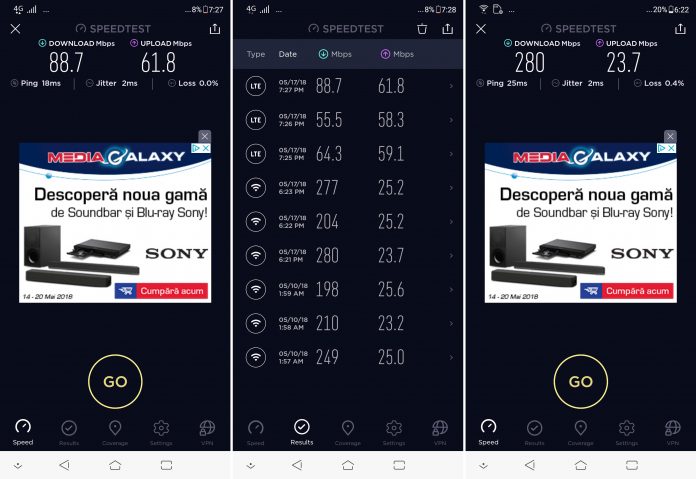
OS, UI, Apps
The handset runs Android 8.0 Oreo of course, with Zen UI 5.0, which doesn’t feel like a big jump from the predecessor. The leftmost homescreen includes the News and Weather and device obviously also offers Multitasking via Split Screen and the famous carousel. Keep the homescreen pressed and you’ll trigger wallpapers, widgets and an option to edit the phone screen in many, many ways.
The basic widgets are white and minimalistic. About the editing, you can mess with icons, scroll effects, icon label, color of fonts, folder theme, layout, app drawer, icon frames and icon packs. The dropdown area has notifications and Quick Settings obviously. Settings took us to Security, with a fingerprint scanner that has a 12 step setup. Unlock was fast but I’ve seen faster.

The Face unlock stuff has a very a long setup, but a very, very fast unlock. Surprisinly so, even. There’s also Smart Lock, Page Marker, Toolbar, Twin Apps (Facebook and Instagram), plus Game Genie (records Full HD videos of your gameplay and even does streaming to Twitch and YouTube). There’s also Zenimoji here, in order to apply an AR mask of a bunny, fox and more, plus there’s an SOS option, Optiflex which speeds up apps, Kids Mode and Easy Mode.
There’s also a “Lift to check phone” feature here and ZenMotion Gestures. Pocket Mode, Glove Moe, Drawing letters are all on the table. We also counted the preinstalled apps, 34 of them, which is not bad. There’s Facebook, Instagram, Mobile Manager, Selfie Master, WebStorage and more.
And now it’s time for a verdict.

Verdict
Pros:
- comfiest 6.2 incher
- good display
- OK performance
- fast navigation menu
- OK PCMARK
- solid speakers
- bonus accessories
- OK Bokeh
- solid colors in pics
- good low light capture
- great 4K Video
- solid video all around
- nice zen UI
- fast Face unlock
- nice AI feature
Cons:
- no way to hide the notch (fixed by update)
- underwhelming GPU
- underwhelming video playback time for the battery
- long charging for 2018
- weird colors in wide angle shots
- no optical zoom
- burnt background in selfies
- not a big increase from ZenFone 4 in photo or video quality
- poor low light video
ASUS ZenFone 5 is exactly what one needs for a midrange phone. It’s got a pretty good performance, good camera, but it also have fierce rivals. Those rivals are cheaper, have batter cameras and better batteries. Nokia 7 Plus is one of them. There are phones beaten by the ZenFone 5, like the Xperia XA2 and Moto X4. Even though in some areas it’s not that big of a jump from the ZenFone 4, the overall impression is that it has more extras compared to the ZenFone 4 than the ZenFone 4 coming from the ZenFone 3.
It’s just a comfy phone, a sexy phone with a decent camera and nice media features (screen, audio). It may become more tempting at $300 or less.










